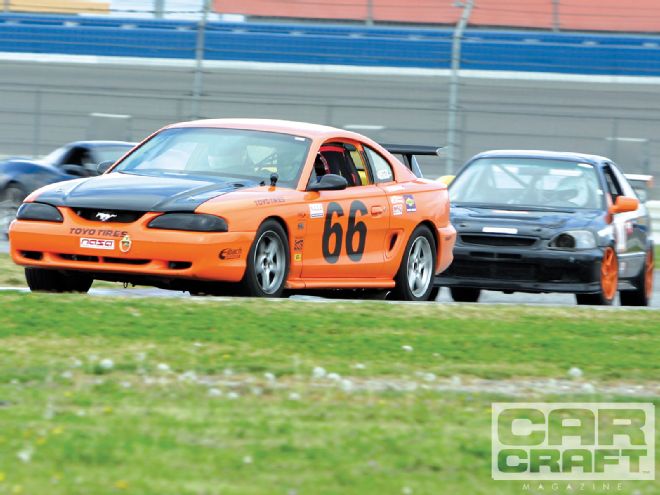
How to race: where Getting your car on a racetrack has never been easier because there have never been as many clubs, companies, and racing organizations offering track days across the country as there are right now. The National Auto Sport Association (NASA) and the Sports Car Club of America (SCCA) have been around for many years. These are national racing organizations that operate through local regions across the country. Both offer novice and relatively inexperienced drivers the opportunity to take to the track in what is commonly referred to as a performance driving experience (worded thusly for insurance reasons) in conjunction with a full weekend of racing at one of their events. You don't need to be a member to participate, either, though you may get a price break if you are.
How to race: private rental Another option is to seek out a private company that rents a track for a day and allows people to register to attend. In California, we have Open Track Racing and Speed Ventures, and similar groups are sprouting up in other parts of the country. One big advantage to attending a company track day is it may have fewer people in attendance than an SCCA or NASA track day. You may be able to spend more time on the track and share it with fewer cars.
How to race: clubs! Car clubs, and more recently, message boards, rent track time. Check the local Shelby, Corvette, Porsche, or Ferrari clubs' schedules. You may be able to tag along even if you don't own that particular car-it is in the club's interest to attract a greater number of cars to amortize the rental fee.
What you Need
Much like ensuring a successful day at the dragstrip, a little preparation before heading to the track can pay dividends that far exceed the investment. To begin with, don't bother to show up unless your car's suspension is in excellent condition. Expired ball joints, rattling suspension bushings, worn tie-rod ends, and shipped-out shocks have no place on a road course or autocross. Road course racing places great strain on all suspension and steering pieces, so it's best to start with good parts. After all, the point of going to the track is to have fun, right?
You'll also need a small assortment of tools in case a bolt loosens up or a leak appears that needs attention. A portable air tank, a small compressor, and a quality air pressure gauge are essential trackside tools that give you the opportunity to make pressure changes to the tires. Most track days that emphasize cars on the course with minimal passing don't require rollbars unless the car is a convertible, but you will need quality seatbelts and a good helmet. NASA's High Performance Driving Experience (HPDE) requires an SA1990, M1990, or newer helmet.
Also bring a cooler with plenty of water, nonsugary snacks or a light lunch, fold-up chairs, and perhaps an expandable tent for some shade during the day. All this might be tough to pack into a '69 Camaro trunk, so you might consider having a friend accompany you to the track with his/her vehicle that can carry the extra gear.
Track Day Setup
Now that you've signed up for a track day excursion, there are some critical mods that must be done so you have a good time, the car doesn't break, and you don't look like a rookie doing it. An easily overlooked area is the brakes. While open track running takes its toll on tires and the drivetrain, the brakes are easily the place where the abuse is the greatest. This means you should spend a some time giving those binders a little love. Even if this is all you do, always bleed the brakes before any serious shot at a road course. Brake fluid is hygroscopic, meaning it absorbs water right out of the atmosphere. Water reduces brake fluid's boiling point and the brake heat will turn that water into steam, which will make the pedal spongy-or worse-fall right to the floor. So completely bleed the entire brake system before you head to the track. And don't use fluid that's been sitting around the shop in an open container for a year. Buy new fluid and bring extra fluid with you-it gives the appearance that you know what you're doing.
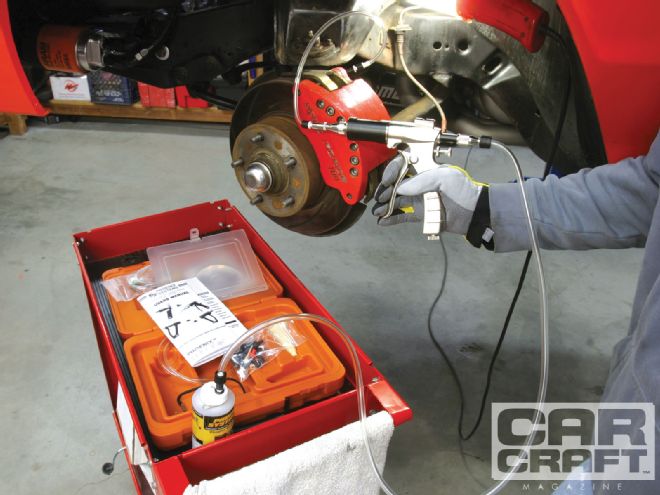 You don't need a fancy tool to bleed the brakes, but we had a chance to try out this cool bleeder tool from Phoenix Systems that uses reverse fluid injection to push new fluid into the calipers, which forces air to exit naturally through the top of the system via the master cylinder reservoir. This system can be used on ABS brake systems as well as more traditional brakes.
You don't need a fancy tool to bleed the brakes, but we had a chance to try out this cool bleeder tool from Phoenix Systems that uses reverse fluid injection to push new fluid into the calipers, which forces air to exit naturally through the top of the system via the master cylinder reservoir. This system can be used on ABS brake systems as well as more traditional brakes.
If you intend to upgrade to a performance brake pad (which is a great idea), be aware that new pads must be properly bedded before going to the track. Bedding procedures vary by manufacturer, but the critical point is that you don't have time to bed the brakes at the track. The best time to do this would be a couple of days before the event, since bedding requires allowing the pads to completely cool to ambient temperature at least once and preferably several times.
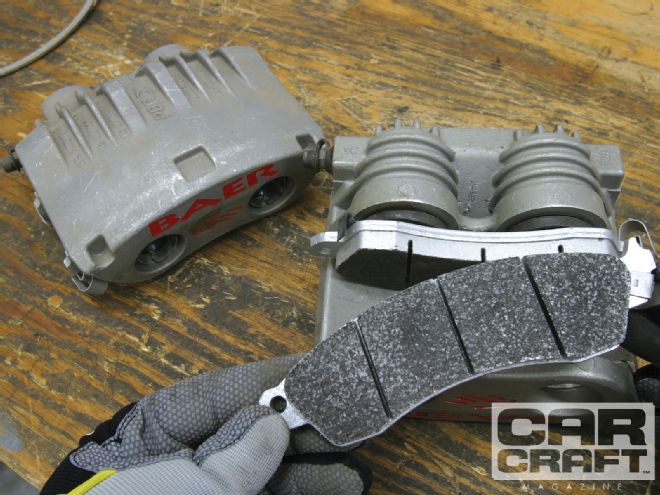 Aggressive track-style brake pads are a good addition, but make sure they are fully bedded through multiple high-heat cycles to ensure that the friction material has been fully outgassed. If the pads are not fully bedded, it's likely they will glaze, which will seriously detract from braking efficiency. You don't want that.
Aggressive track-style brake pads are a good addition, but make sure they are fully bedded through multiple high-heat cycles to ensure that the friction material has been fully outgassed. If the pads are not fully bedded, it's likely they will glaze, which will seriously detract from braking efficiency. You don't want that.
Alignment is another important issue. If your car has an improved suspension that has an aggressive front camber curve, then the car can maintain its street alignment and give up very little handling performance. As an example, our mule Chevelle is equipped with a very aggressive Global West front upper control arm that allows us to run 1.5 degrees of static negative camber and 6 degrees of positive caster. The car enters the corners very nicely without the need for additional static negative camber. However, back when the car was equipped with stock upper control arms and spindles, it needed roughly 4 degrees of negative camber to plant the tires. With camber, the goal is to produce even tire temperatures across the face of the tire.
Running a car at an autocross is a relatively quick event, much like a drag race, so heat management isn't quite as important an issue as it is on a road course. If you plan on abusing your car on an open track day at a big road course, spend a little time beforehand ensuring the cooling system is in excellent shape. Also remember that at a big track, you are going to be on the throttle for an extended period of time, which will also significantly elevate transmission and rear axle oil temperatures. Consider changing the gear oil in the rearend and in the manual trans with a high-quality synthetic that will handle the temperature. If your car is running an automatic, a large aftermarket trans cooler is essential. It is best to keep the trans temperature less than 225 degrees F, which may limit the number of laps you can run without a cool down. You should also consider running a power steering cooler. We've seen multiple power steering pump failures at big tracks due to cooked fluid.
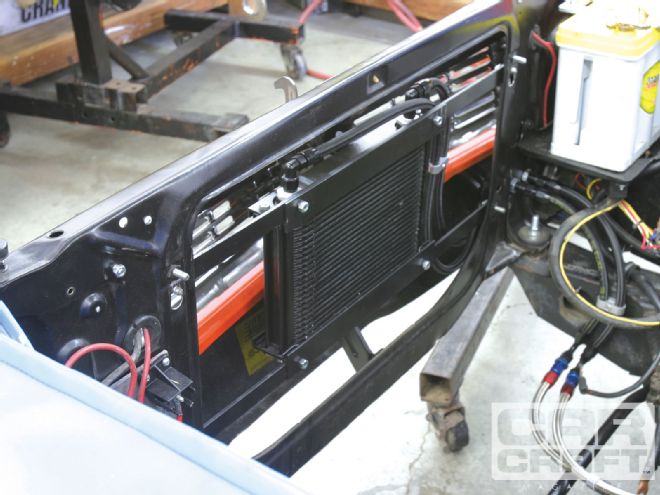 If your track car has an automatic transmission, don't even consider going to a track day or autocross without a large, high-efficiency trans cooler located in the direct path of cool air. Stock factory trans coolers are not of sufficient size or capacity. Also consider installing a trans temperature gauge and park the car if the temp exceeds 225 degrees F.
If your track car has an automatic transmission, don't even consider going to a track day or autocross without a large, high-efficiency trans cooler located in the direct path of cool air. Stock factory trans coolers are not of sufficient size or capacity. Also consider installing a trans temperature gauge and park the car if the temp exceeds 225 degrees F.
Driving Lessons
Above vehicle preparation, the most important thing you can take to the track with you is driver skill. A good driver in a mediocre car can be bullet quick compared with a mediocre driver in a first-class machine. Don't expect to set fast lap times your first few times out. Better yet, attending an autocross driver's school or on-track classes such as those sponsored by the SCCA or NASA is a great place to learn vehicle dynamics and the proper line through a corner. After attending several driving schools, you will learn that a measured and consistent performance in the cockpit will always deliver superior lap times over frenetic maneuvers attempting to save the car after an ill-advised corner entry.
Entire libraries have been written in the name of describing the art of driving, so we'll limit our discussion to corner entry and corner exit. Novice drivers assume that a fast entry into a corner will equal a faster exit speed. While not entirely untrue, for the entry-level driver, the better approach is to be smooth on corner entry under full control. Combining this with the proper line through the corner will allow you to apply the throttle sooner. This will ultimately produce a higher exit speed and a lower lap time. The critical corner on any autocross or road course is always the one that leads onto the longest straight. To conquer that corner, the essential points to consider are to brake and downshift in a straight line-you can master the art of trail braking once you have the basics down. The apex of many turns is not the geometric center of the corner. Often, it is much later in the curve. Good autocross racers prefer walking the course slowly, which gives them time to study each turn in depth. The whole idea of cornering quickly is to widen the turn as much as possible. There is a lifetime learning curve available to those interested in becoming proficient, but the only way to do that is to dive right in and start logging seat time.
Tires-The Big Equalizer
If there is one single component that has the greatest effect on handling and lap times, it is unquestionably tires. We'll dive into some basics to give you an idea of what to look for rather than just fall in with the rest of the cats who follow the hot tire of the week chatter on the Internet.
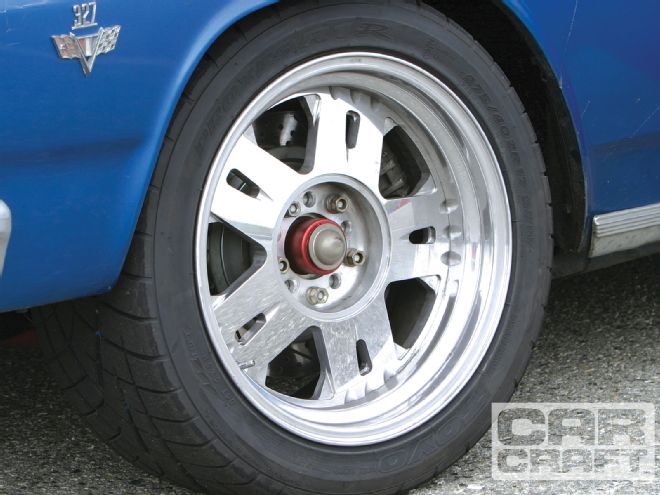 The combination of a good suspension and sticky tires is tough to beat. We used a set of these Toyo Proxes R1R tires on our test Chevelle. The Toyo Proxes R1R tires have a 140 treadwear rating that is easily found on the sidewall of the tire. The scuff pattern on the edge of the tread indicates air pressure on this front tire is very close to ideal as it is planting virtually all of the tread on the pavement without rolling over onto the sidewall.
The combination of a good suspension and sticky tires is tough to beat. We used a set of these Toyo Proxes R1R tires on our test Chevelle. The Toyo Proxes R1R tires have a 140 treadwear rating that is easily found on the sidewall of the tire. The scuff pattern on the edge of the tread indicates air pressure on this front tire is very close to ideal as it is planting virtually all of the tread on the pavement without rolling over onto the sidewall.
We'll assume you've already worked out the largest tire and wheel combo you can stuff under your car. Choose the lightest, widest wheels you can cram under those wheelwells. A wider wheel can plant much more tread on the ground. If you're not sure of an ideal width, all tire manufacturers list recommendations for each tire size. As for rim diameter, the most popular size is 17, but 18 is gaining favor.
The biggest compromise when choosing a tire is the dilemma between traction and treadwear. Gumball soft race rubber is great for quick lap times, but it's possible to kill a set of tires in as little as two race sessions if you put in a bunch of laps. Perhaps more realistic is the wide selection of DOT-legal tires from a multitude of companies. Race sanctioning bodies that establish tire rules usually employ the Uniform Tire Quality Grading (UTQG) treadwear rating. This is a reference number that indicates how quickly the tread will wear. Using 100 as the reference number, a 200 tire will last twice as long. This rating is listed directly on the sidewall. Generally, a lower number refers to a softer tread. A lower number does not necessarily mean a stickier tire since tire construction, tread depth, and a dozen other variables also come into play. While most tire companies offer only one compound of DOT race tire, there are some, such as Hoosier, that offer an autocross and road race tire. While you might be tempted to try a set of autocross tires on a road course, the heat generated by the road course will literally melt the tread right off a set of autocross tires in perhaps one to three laps.
The combination of a good suspension and sticky tires is tough to beat. We used a set of these Toyo Proxes R1R tires on our test Chevelle. The Toyo Proxes R1R tires have a 140 treadwear rating that is easily found on the sidewall of the tire. The scuff pattern on the edge of the tread indicates air pressure on this front tire is very close to ideal as it is planting virtually all of the tread on the pavement without rolling over onto the sidewall.